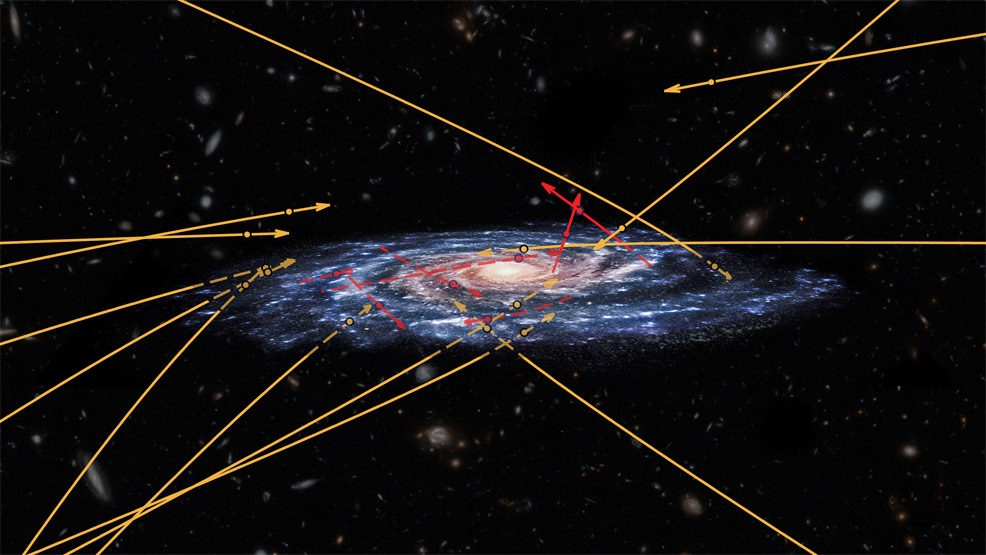
5th October 2018 "Runaway" stars found hurtling towards Milky Way Astronomers report the discovery of rogue, high-velocity stars hurtling towards the Milky Way, possibly originating from another galaxy.
A team of astronomers using the latest set of data from the European Space Agency (ESA)'s Gaia mission to look for high-velocity stars being kicked out of the Milky Way were surprised to find stars instead sprinting inwards – perhaps from another galaxy. Their study is published in the journal Monthly Notices of the Royal Astronomical Society. Stars circle around our galaxy at an average of about 100 kilometres (62 miles) per second. Their motions contain a wealth of information about the past history of the galaxy. The fastest stars are called hypervelocity stars, which move 10 times faster, at 1,000 kilometres (620 miles) per second. They are thought to start their life near the galactic centre, later to be flung towards the edge of the Milky Way via interactions with the black hole at its centre. Only a small number of hypervelocity stars have ever been discovered, and Gaia's recently published second data release provides a unique opportunity to look for more of them. "Of the seven million stars with full 3D velocity measurements, we found 20 that could be travelling fast enough to eventually escape from the Milky Way," explains Elena Maria Rossi, one of the authors of the new study, based at Leiden University in the Netherlands.
However, the team were in for a surprise: “Rather than flying away from the Galactic centre, most of the high-velocity stars we spotted appear to be racing towards it,” adds co-author Tommaso Marchetti. “These could be stars from another galaxy, zooming right through the Milky Way.” It is possible that these intergalactic stars originated from the Large Magellanic Cloud – a relatively small satellite galaxy orbiting the Milky Way at a distance of 160,000 light years; or they may originate from a galaxy much further afield. If that is the case, they carry the "imprint" of their site of origin. Studying them at much closer distances than their parent galaxy could provide unprecedented information on the nature of stars from another galaxy – similar in a way to studying Martian material brought to our planet by meteorites. “Stars can be accelerated to high velocities when they interact with a supermassive black hole,” Rossi explains. “So the presence of these stars might be a sign of such black holes in nearby galaxies. But the stars may also have once been part of a binary system, flung towards the Milky Way when their companion star exploded as a supernova. Either way, studying them could tell us more about these kinds of processes in nearby galaxies.” An alternative explanation is that the newly identified stars could be native to our Galaxy’s halo, accelerated and pushed inwards through interactions with one of the dwarf galaxies that fell towards the Milky Way during its earlier history. Additional information about the age and composition of the stars could help the astronomers clarify their origin. New data could help to nail down the nature and origin of these stars with more certainty, and so the team will use ground-based telescopes to find out more about them. At least two more Gaia releases are planned for the 2020s – these will provide more precise data, and on a larger set of stars. “We eventually expect full 3D velocity measurements for up to 150 million stars,” explains co-author Anthony Brown, chair of the Gaia Data Processing and Analysis Consortium Executive. “This will help find hundreds or thousands of hypervelocity stars, understand their origin in much more detail, and use them to investigate the Galactic centre environment, as well as the history of our Galaxy," he adds. “This exciting result shows that Gaia is a true discovery machine – providing the ground for completely unexpected discoveries about our Galaxy,” concludes Gaia project scientist at ESA, Timo Prusti.
Comments »
If you enjoyed this article, please consider sharing it:
|










